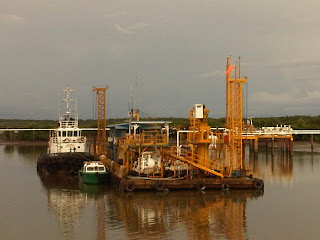Production Facilities
 |
| Well Testing Barge |
The fluid produced from a well is usually a mixture of oil, gas, water, and sediment in varying amounts and at elevated temperatures and pressures. The oil alone is a complex mixture of many hydrocarbon compounds, including compounds which enter the gas phase during the production process. Gas may also be produced from the reservoir in varying amounts and travel up the tubing as bubbles entrained in the oil. Alternatively, oil droplets may be entrained as a mist in the gas. Formation water may be carried in the gas as water vapor, emulsified as droplets within the oil, or produced as free water containing dissolved gas, dissolved salts, and entrained oil. Sand and silt from the formation and rust or scale from the tubing or casing may also be included in the produced fluid stream, along with CO2, H2S, and other nonhydrocarbon contaminants. These elements may be present in a wide range of relative proportions, so it is easy to see the reason for the wide variety of production processing equipment used in our industry.
Surface production facilities must be designed to turn this mixture into separate streams of clean, dehydrated oil and gas, and safely disposable water and solids. The oil and gas must be metered and sold to a pipeline or delivered to a plant or refinery for further processing.
The system begins at the wellhead, which for flowing wells will usually include a choke to control the flow rate. The pressure drop across the choke is determined by the flowing tubing pressure (upstream) and the initial process vessel operating pressure (downstream) . Varying the choke size varies the flow rate. When two or more wells are commingled at a central processing facility, it is necessary to use a production manifold to combine the flow streams or to divert a single stream for testing or special treatment.
[post_ad]
The first component of the processing facility the produced fluid encounters is typically some type of separator. Separators manipulate the stream of produced fluid to take advantage of the density differences that exist among gas, oil, and water and that cause these phases to separate. A two-phase separator separates gas and liquids; a three-phase separator goes one step further and separates oil and water as well. Separators come in a variety of configurations and operating pressures depending on the degree of gas-oil separation desired and the producing pressure of the Production stream. Stage separation, which typically involves high, intermediate and low pressure separators in series, can maximize oil volumes and allow several
wells with a variety of flowing tubing pressures to be serviced by the same facility. Because a separation vessel is normally the initial Processing vessel in any facility, improper design of this component can cause a bottleneck and reduce the capacity of the entire system.
The first component of the processing facility the produced fluid encounters is typically some type of separator. Separators manipulate the stream of produced fluid to take advantage of the density differences that exist among gas, oil, and water and that cause these phases to separate. A two-phase separator separates gas and liquids; a three-phase separator goes one step further and separates oil and water as well. Separators come in a variety of configurations and operating pressures depending on the degree of gas-oil separation desired and the producing pressure of the Production stream. Stage separation, which typically involves high, intermediate and low pressure separators in series, can maximize oil volumes and allow several
wells with a variety of flowing tubing pressures to be serviced by the same facility. Because a separation vessel is normally the initial Processing vessel in any facility, improper design of this component can cause a bottleneck and reduce the capacity of the entire system.
TweetFollow @industrimigasTweet to @industrimigas
Production Facilities
 Reviewed by Industri Migas
on
11:28 PM
Rating:
Reviewed by Industri Migas
on
11:28 PM
Rating:
 Reviewed by Industri Migas
on
11:28 PM
Rating:
Reviewed by Industri Migas
on
11:28 PM
Rating:





Very useful article. Thank You
ReplyDeleteThank you for visit industrimigas.com
Deletelike industrimigas.com facebook fanpage or follow our twitter to get more information that you need and share it.